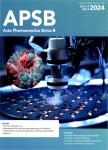GSH-sensitive polymeric prodrug: Synthesis and loading with photosensitizers as nanoscale chemo-photodynamic anti-cancer nanomedicine
GSH-sensitive polymeric prodrug: Synthesis and loading with photosensitizers as nanoscale chemo-photodynamic anti-cancer nanomedicine作者机构:Huaxi MR Research Center(HMRRC)Department of RadiologyFunctional and Molecular Imaging Key Laboratory of Sichuan ProvinceNational Clinical Research Center for GeriatricsWest China HospitalSichuan UniversityChengdu 610041China College of Pharmaceutical SciencesSouthwest UniversityChongqing 400716China Research Unit of PsychoradiologyChinese Academy of Medical SciencesChengdu 610041China Amgen Bioprocessing CentreKeck Graduate InstituteClaremontCA 91711USA
出 版 物:《Acta Pharmaceutica Sinica B》 (药学学报(英文版))
年 卷 期:2022年第12卷第1期
页 面:424-436页
核心收录:
学科分类:1007[医学-药学(可授医学、理学学位)] 1004[医学-公共卫生与预防医学(可授医学、理学学位)] 1002[医学-临床医学] 1001[医学-基础医学(可授医学、理学学位)] 100214[医学-肿瘤学] 10[医学]
基 金:financially supported by the National Natural Science Foundation of China(82073790,51873120,51673127,and 81621003) 1·3·5 project for disciplines of excellence,West China Hospital,Sichuan University,China(ZYJC21013,ZYGD18028)。
主 题:Stimuli responsiveness Polymeric prodrug Photodynamic therapy Combinational therapy Nanomedicine
摘 要:Precisely delivering combinational therapeutic agents has become a crucial challenge for anti-tumor treatment. In this study, a novel redox-responsive polymeric prodrug(molecular weight,MW: 93.5 k Da) was produced by reversible addition-fragmentation chain transfer(RAFT) polymerization. The amphiphilic block polymer-doxorubicin(DOX) prodrug was employed to deliver a hydrophobic photosensitizer(PS), chlorin e6(Ce6), and the as-prepared nanoscale system [NPs(Ce6)] was investigated as a chemo-photodynamic anti-cancer agent. The glutathione(GSH)-cleavable disulfide bond was inserted into the backbone of the polymer for biodegradation inside tumor cells, and DOX conjugated onto the polymer with a disulfide bond was successfully released intracellularly. NPs(Ce6) released DOX and Ce6 with their original molecular structures and degraded into segments with low MWs of 41.2 k Da in the presence of GSH. NPs(Ce6) showed a chemo-photodynamic therapeutic effect to kill 4 T1 murine breast cancer cells, which was confirmed from a collapsed cell morphology, a lifted level in the intracellular reactive oxygen species, a reduced viability and induced apoptosis. Moreover, ex vivo fluorescence images indicated that NPs(Ce6) retained in the tumor, and exhibited a remarkable in vivo anticancer efficacy. The combinational therapy showed a significantly increased tumor growth inhibition(TGI,58.53%). Therefore, the redox-responsive, amphiphilic block polymeric prodrug could have a great potential as a chemo-photodynamic anti-cancer agent.



